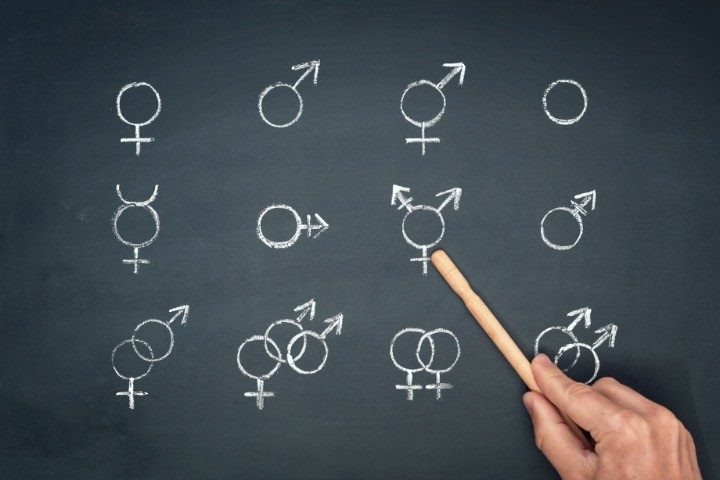
A new government report from the 2023 Youth Risk Behavior Survey (YRBS) has drawn attention to alarming trends related to the promotion of transgenderism among young Americans. According to the U.S. Centers for Disease Control and Prevention (CDC), 3.3 percent of high school students now identify as transgender, with an additional 2.2 percent “questioning” their sex.
One important finding shows that white students are more likely to identify as “transgender” or “questioning” than students from other racial and ethnic backgrounds. Meanwhile, black students are the least likely to experience confusion about their sex.
Each year, the CDC gathers data from a nationally representative group of students in grades 9 through 12, spanning public and private schools across all 50 U.S. states and the District of Columbia.
Inflated Numbers?
The reported percentage of transgender high schoolers — 3.3 percent — appears grossly inflated, especially when compared to historical trends.
There are two possible explanations for this striking figure. The first is that the CDC may be misrepresenting the data by suggesting that one in thirty students identifies as transgender. Historically, the number of school-age children identifying as transgender was significantly lower. It’s important to note that self-identification does not equate to a medical diagnosis of gender dysphoria, which requires formal assessment by healthcare professionals. The extensive Reuters report on the topic conflates the two. Which is no surprise, since the recently established medical practice is to accept a child’s “identity” at face value.
According to the report, from 2017 to 2021, about 121,882 children aged 6 to 17 were diagnosed with gender dysphoria in the U.S. Most of these diagnoses likely apply to teens aged 14 to 18. Older teens tend to receive more diagnoses than younger children due to puberty-related distress.
In 2021 alone, out of 40 million American children and teens, 42,000 were diagnosed or identified as transgender. That represents 0.1 percent of youth, marking a significant increase compared to the 0.038 percent recorded in 2017.
Assuming no significant changes in other factors (diagnostic criteria, social environment, etc.), the latest 3.3 percent figure is far too high and contradicts previous medical data.
Social Contagion?
The second explanation is more troubling. If these numbers are even close to accurate, then some profound and unprecedented influence has driven this dramatic rise. That is most likely a “social contagion.” The phenomenon refers to the spread of behaviors, ideas, and attitudes through peer influence, media exposure, and cultural shifts. In this case, the rapid increase in transgender identification among adolescents suggests that external social forces — particularly in schools, entertainment, and social media (see here, here, and here) — are playing a significant role in shaping how young people perceive and explore “gender.” This raises concerns that natural adolescent struggles may be recast as issues of “gender identity.” This leads to irreversible decisions driven more by cultural trends than by individual psychological needs.
This topic was addressed in depth by, among others, prominent child psychologist Dr. Miriam Grossman. She spoke on the matter with The New American magazine in 2023.
Rejecting Biological Reality
The CDC report perpetuates the false notion that sex is “assigned” at birth, a concept that has no grounding in biology. The introduction reads:
Gender refers to the socially constructed norms and expectations imposed on persons according to their designation as male or female sex at birth. Gender identity refers to a person’s sense of self and personal experience of gender.
In this context, a “transgender” is defined as a person “whose gender identity differs from their sex assigned at birth.”
Clearly, CDC researchers reject the idea that sex is an objective biological fact determined by chromosomes and immutable characteristics. No amount of surgery or hormone treatment can change the biological reality of male or female. Promoting or allowing children and teens to “transition” is not only misleading, but also harmful. The irreversible nature of surgeries and hormone treatments, such as puberty blockers, raises significant ethical concerns. Despite the fact that these procedures permanently alter the body, the government fully endorses their application to youth. As a result, misinformed parents and minors who are not capable of fully understanding the long-term consequences accept these guidelines.
Mental Health: The Real Crisis
The report focuses on the high rates of mental health issues among “transgender” students. Per the report:
An estimated 40% of transgender and questioning [their gender] students were bullied at school, and 69% of questioning students and 72% of transgender students experienced persistent feelings of sadness or hopelessness, a marker for experiencing depressive symptoms. Approximately 26% of transgender and questioning students attempted suicide in the past year, compared with 5% of cisgender male and 11% of cisgender female students.
Yet the CDC fails to acknowledge that transitioning is not a solution to these issues. The data suggest that the mental health crisis among transgender youth is not due to a lack of “affirmation” or support — it stems from the nature of gender dysphoria itself. Promoting sex change as a solution to psychological distress is deceptive and harmful.
The report overlooks that studies show transitioning does not result in long-term mental health improvements. Instead, “transitioned” young people are often left with regret, irreversible physical changes, and continued mental health struggles. Rather than addressing the underlying causes of their distress, the current approach pushes them further into a destructive cycle.
Role of Public Schools
Perhaps most troubling is the role of public schools in advancing this ideology. Schools, under the guise of “support” and “inclusivity,” are actively promoting the normalization of “gender” fluidity. They often do so without involving or informing parents. Policies now allow students to use bathrooms and locker rooms of the opposite sex. They also permit participation in sports based on chosen “gender identity.” These measures undermine the boundaries of biological reality.
Instead of fostering a safe space for all, such policies create confusion and conflict. They push a one-sided agenda that encourages students to question their sex, and transitioning as not only normal but desirable. The report’s findings should prompt schools to rethink their role in promoting this ideology. They serve as a warning against further policies that deepen gender confusion.
Returning to Reality
The high rates of mental health issues, violence, and suicidal behavior among transgender students reported in the YRBS should not justify more “gender-affirming” interventions. Instead, they highlight that the current approach is failing these young individuals. This evidence points to the need for a reassessment of strategies rather than reinforcing existing ones. Instead of pushing irreversible medical treatments and confusing ideologies, schools and society should return to a reality-based understanding of sex, one rooted in biological fact. Adolescents need psychological support, not ideological indoctrination. Transitioning will not cure gender dysphoria, and the risks involved in affirming these confused feelings in children are far too great to ignore.
The findings in this report raise significant red flags about the direction society is heading in when it comes to youth and sex. It’s time to take a critical look at the real motives behind the push for transgenderism, and to protect the health and well-being of children from harmful ideologies.



